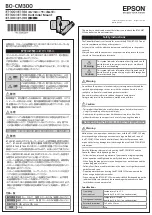
16
GB/IE/NI
• Observe your surroundings and look out for var-
iables such as pedestrians, cyclists and traffic/
vehicles .
• Find a large, wide, open area without obstruc-
tions; pay particular attention to buildings,
crowds, power lines and trees .
• For aerobatic activities, such as loops, there
should be a space of approx . 10m in all direc-
tions .
• Take care to select a dry and rain free environ-
ment . Do not fly the quadrocopter in poor or
damp weather conditions (e .g . in snow, fog or at
night) . The quadrocopter must only be operated
when visibility is good .
• The quadrocopter may only be operated in
temperatures between 10°C and 45°C .
• Pay attention to the restrictions in the Drone
Ordinance in respect of prohibited areas (see
the section on “Safety information”) .
Flight preparation
Pay attention to the following, before you start
flying the quadrocopter (1):
1 . Always place the quadrocopter (1) on an even
surface for take-off .
NOTE:
The camera lens indicates the front
of the quadrocopter (1) .
2 . Always move the throttle (2h) and control
lever (2l) slowly and carefully, with sensitivity .
NOTE:
After activation, the control lever
springs back to the centre position, and the
quadrocopter rises/lowers a specific height
and remains there .
3 . Keep your attention continuously focused on the
quadrocopter during the flight (1)!
CAUTION:
Always keep the quadrocop-
ter in sight during flight operations!
4 . Do not hang any loads onto the
Quadrocopter (1) .
CAUTION:
Check the rotor protection
(1c) (Fig . B) before each flight to ensure
that it is secure and undamaged .
Otherwise there is a risk of damage to the rotor
blades (1a), (1b) during a flight and this may
cause injury .
Personal space
Always make sure to respect the personal space
of other people and animals around you . Do not
film people close up unless they have given you
permission to do so .
Note also that it is not always permitted to film
wherever and whenever you wish .
Pay attention to the applicable legal provisions .
Taking off and controlling the
quadrocopter
When flying, watch out for foreseeable misuse as
a result of:
• Sudden changes in the weather
• Sudden changes in wind (gusts)
• Loss of visibility
• Direct sunshine (overheating, loss of control as a
result of dazzle) .
Taking off (Fig. J)
1 . Turn the quadrocopter (1) to the OFF position via
the switch (1d) .
2 . Press the on/off switch (2a) on the remote con-
trol (2) (Fig . J) . The display lights blink (2j) .
NOTE:
Always switch the remote control (2)
on first .
3 . Insert the current-regulating cable (9b) into the
designated plug-in connector of the quadrocop-
ter .
4 . Connect the battery plug-in connector (9a) to
the Quadrocopter plug-in connector .
5 . Switch the on/off switch (1d) to the ON position
(Fig . J) . The control indicators (1h) of the quad-
rocopter (1) blink alternately and a signal tone is
emitted from the remote control (2) .
6 . Slide the throttle (2h) all the way forward, and
then all the way back .
NOTE:
This process establishes contact be-
tween the quadrocopter (1) and the remote
control (2) .
If the throttle (2h) is not first moved forward and
then back, the quadrocopter (1) remains secured
and will not be ready for flight . Acoustic signals
are emitted from the remote control (2) . The control
lights (1h) on the quadrocopter (1) light up continu-
ously . The quadrocopter (1) is now ready for flight .





































![Navig[8]r NAV-RCDRONE15 User Manual preview](http://thumbs.mh-extra.com/thumbs/navig-8-r/nav-rcdrone15/nav-rcdrone15_user-manual_3573005-01.webp)






